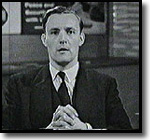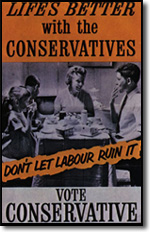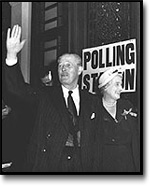
|
8 October 1959Harold Macmillan, the popular leader of the Conservatives, won the Tories an historic third successive term in office. A prosperous and complacent Britain was content to return the Tories to power, although Labour had an attractive new leader in the shape of Hugh Gaitskell.
Background
In the two years between coming to power and the general election of 1959, Macmillan worked miracles. When he entered Number 10, Labour were 13 points ahead in the opinion polls and by the time election was called the Conservatives enjoyed a seven point lead. Clement Attlee retired as the leader of the Labour Party in 1955 after Labour's second successive general election defeat. Hugh Gaitskell emerged as the Party's new leader and quickly papered over the party's Bevanite divisions. For the first time in nearly a decade, a Labour victory looked possible. The economy formed the battleground for the election. Macmillan's record in office was mixed but it was undeniable that the economy had enjoyed an upswing in recent years. Many Britons were able to buy consumer durables such as televisions, washing machines, cars and fridges for the first time. And with the country feeling the effects of a generous budget, Macmillan set the date for the election as 8 October 1959.
Labour's manifesto, Britain Belongs to You, offered voters an increase in pensions and the municipalisation of rented housing. Hugh Gaitskell was trumpeted as "the man with the plan" and Labour attempted to capitalise on the new medium of television that was transforming the public's perception of politics. More than 70% of British homes were now equipped with TV sets. Labour hoped to use TV to present Gaitskell as Britain's next prime minister. Broadcaster Ludovic Kennedy described Labour's election broadcasts, masterminded by Tony Benn, as "smooth, glossy and slick". Despite this and despite labelling television studios a "twentieth century torture chamber", Macmillan got the best of the television coverage. His final address to the voters attracted the highest viewing figures of the entire campaign. During the campaign, Macmillan proved himself a more skillful politician than Gaitskell. When the Labour leader promised to raise pensions, build more hospitals and keep taxes down he was greeted with suspicion by some voters. When he later promised to reduce purchase tax in addition to his previous commitments, the Tories were quick to exploit his gaffe with the gibe, "A bribe a day keeps the Conservatives away". The Liberals, under leader Jo Grimond, fought a wider campaign than in previous years, contesting 216 seats compared to 110 in 1955. With the nation ready to cast their votes, the Conservatives had a 2-3 point lead over Labour.
The Liberals' decision to field double the number of candidates compared to 1955, did see its share of the vote increase from 3% to 6%. However, their number of seats remained unchanged at six. Macmillan had won by successfully portraying the Conservative Party as the party of prosperity. Two new Conservatives who entered the House for the first time on the back of Macmillan's success were Margaret Thatcher and Nicholas Ridley. The veteran Labour politician Herbert Morrison retired. The Conservatives had now won their third successive election victory. This had not happened since the nineteenth century and some commentators began asking if the Labour Party would ever be returned to office.
|
Diana, Princess of Wales, 1961-1997
Conference 97
Devolution
The Archive
News |
Issues |
Background |
Parties |
Analysis |
TV/Radio/Web
Interactive |
Forum |
Live |
About This Site
News |
Issues |
Background |
Parties |
Analysis |
TV/Radio/Web
Interactive |
Forum |
Live |
About This Site
© BBC 1997 |
politics97@bbc.co.uk |


